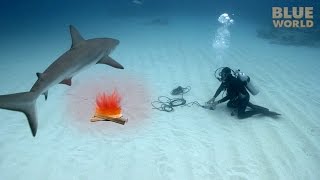(单词翻译:单击)
This time on Jonathan Bird's Blue World, investigating shark electrosensory systems!
在本期的乔纳森《蓝色世界》中,我们将一起探讨鲨鱼的电感应系统!
Hi I'm Jonathan Bird, and welcome to my world!
嗨,我是乔纳森·伯德,欢迎来到我的世界!
One thing that has always been true about sharks is that they seem to love my camera.
关于鲨鱼,有一件事一直是真的,那就是它们似乎喜欢我的摄像机。
Sharks get right up close to the lens.
鲨鱼靠近镜头。
This makes great, dramatic footage.
这个很棒,一个戏剧性的镜头。
And lots of TV shows--not this one--try to use this behavior to make sharks look aggressive.
很多电视节目,不是这个节目,都试图用这种行为让鲨鱼看起来具有攻击性。
Well, it's not aggression.
好吧,这不是攻击。
They just want to be TV stars!
它们只想成为电视明星!
No it's not that either.
不,也不是那样。
Sharks have a snout full of pores called Ampullae of Lorenzini,
鲨鱼有一个充满毛孔的鼻子,叫做洛伦氏壶腹,
whose sole purpose is to detect tiny electrical currents in the water.
其唯一的用途是探测水中的微小电流。
All living things make tiny electrical currents, and sharks can sense them.
所有的生物都能产生微小的电流,鲨鱼也能感觉到。
They use this skill to help them hunt in complete darkness.
它们用这种技能在一片漆黑中捕食。
My video camera produces a tiny electrical field in the water, and it makes the sharks curious.
我的摄像机在水中产生出微小的电场,这让鲨鱼很好奇。
They're bumping the camera to investigate.
它们正在用摄像机进行查看。
During the day, this shark can see me with its eyes…but in pitch darkness could it still detect my electrical signature?
这条鲨鱼白天时可以用眼睛看到我,但在漆黑的环境中,还能探测到我的电信号吗?
And from how away?
离这里有多远?

To learn more about how the shark's electrosensory system works, I have come to one of the "sharkiest" places in the world— the Bahamas.
为了进一步了解鲨鱼的电感应系统的工作方式,我来到了世界上最“危险”的地方之一——巴哈马。
And I just happen to have brought with me an expert in shark electrosensory systems!
我正好带来一位鲨鱼电感应系统专家!
Dr. Stephen Kajiura is a shark biologist at Florida Atlantic University in Boca Raton.
斯蒂芬·卡久拉博士是博卡拉顿佛罗里达大西洋大学的鲨鱼生物学家。
He is going to show me how sharks can sense electricity with a simple experiment.
他将通过简单的实验,向我展示鲨鱼感知电的方式。
Basically what we are trying to do here is simulate the electric field produced by a natural prey item
基本上,我们要做的是模拟一个自然猎物,
—a little fish or a crab or something.
即一条小鱼或一只螃蟹或其他什么东西产生的电场。
All sharks have the ability to detect electrical fields,
所有鲨鱼都有探测电场的能力,
and you can see those little pores all over the surface of the head—those are all electroreceptors.
你能看到遍布其头部表面的小毛孔,这些都是电受体。
So what we are doing is, by creating an electric field in the environment here,
所以,我们现在所做,是在这个环境中创造出电场,
what we will be able to demonstrate is the sharks orienting to just the electric stimulus.
我们就能证明的是鲨鱼仅定向于电刺激。
We will have two identical targets, one will be active, one will be a control treatment,
我们会有两个相同的目标,一个是自主的,一个是控制型的,
and then you will see that they are going to swim right over the control, ignore it completely, and bite only at the active electric target.
然后你会看到鲨鱼游过控制型猎物上方,完全忽略它,然后只咬自主活动的电动目标。
Dr. Kajiura puts the equipment together.
卡久拉博士把设备组装起来。
We will take it underwater to do some tests with the sharks.
我们要把它带到水下,和鲨鱼做一些测试。
Dr. Kajiura, Julia and I gear up for a dive to set up the experiment.
我、卡久拉博士和茱莉亚准备潜水做实验。
Julia has brought down the plexiglass base.
茱莉亚把有机玻璃底座弄了下来。
It will be partially buried in the sand so it won't draw attention to itself.
它将一部分埋在沙子里,这样就不会引起注意。
Dr. Kajiura connects the electrodes to a cable, so he can back up far enough to keep from affecting the sharks' behavior.
卡久拉博士将电极连接到一根电缆上,这样他就可以向后退得足够远,以免影响鲨鱼的行为。
Next he buries the cables in the sand.
然后,他把电缆埋在沙子里。
Working underwater is slow going.
在水下工作时,速度很慢。


